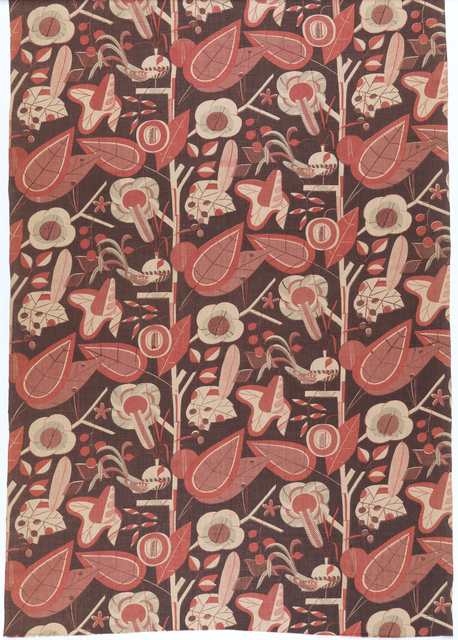Josef Hillerbrand (1892-1981), was a German-born architect and painter who also designed textiles, as well as carpets, ceramics, glass, metalwork, furniture, lighting, and interiors. He received his formal training from the Kunstgewerbeschule (School of Arts and Crafts) in Munich, where in 1922 he was asked by Richard Rimmerschmid, a prominent Art Nouveau artist and designer, to teach. He also taught at the Academy of Applied Arts in Munich. However, in 1923, shortly after his appointment to the Kunstgewerbeschule, Hillerbrand began work at the Deutsche Werkstätten in the newly formed Textilgesellschaft mbH, or the textile division, where he was a prominent figure until 1945. The Deutsche Werkstätten, like many contemporary workshops, was born out of a recommitment to craftsmanship and the applied arts that was sweeping Germany – at the DeWe a community of artists created and promoted a sort of “mainstream modernity,” and ultimately the workshop was one of the most successful of its kind (Harrod, p. 21).
Textiles had always been an important element of the Deutsche Werkstätten’s productivity since its inception, but block-printed textiles such as this work from the collection began to take on increased importance in the workshop (Jackson, p. 42). There patterns, which were much more bold than ever before, seem to suggest a moving away from the past, and a rebirth, a recommitment to a new, more colorful world. This textile, which is dated to 1926, is featured in the 1928 DeWe Yearbook or Jahrbuch Der Deutsche Werkstättenin the Bunte Stoffe (color fabrics) category. The Yearbook celebrates the fabrics for their vivacious colors, which have replaced the dull grays and browns of days gone by, and names the bright fabrics as ideal decoration for the home. In the Yearbook from the following year, 1929, the textile is illustrated again in a different colorway, however this time it has been made into pajamas. There is also evidence to suggest that this textile was used as upholstery fabric. In each case, the fabric, though in different colorways and used multiple ways, reads as fun and fresh, even friendly and inviting. The bold, block printed flowers, trees, and birds stand apart from the colored ground – the fabric is decidedly modern with its adoption of bright hues and abandonment of representation. Here in the Museum’s version, the eye dances from branch to branch, through the repeat, off the off-white, to the various pinks, onto the pale gray, and vibrates back off the warm brown background.
This bold fabric is indicative of Hillerbrand’s work. Lesley Jackson says, “During the mid-1920s stylized leaves and flowers became a recurrent theme, used as a vehicle for geometricized infill patterns, with a lively interplay between flat colour and fine line” (Jackson, p. 44). Hillerbrand capitalized off abstraction and an adventurous use of colors. As we see in the pink of the Museum’s piece, Hillerbrand would often use ‘variants of one intense shade’ and a bold background (Jackson, p. 44). While according to Jackson, Hillerbrand was also known to use more subtle patterns that were less intense, and characterized by simplified geometrics, this work “…shows Hillerbrand at the height of his powers” (Jackson, pp. 43-44). In looking at this work not only do we get a sense of Hillerbrand’s design aesthetic, we gain a glimpse into the types of versatile works produced in the textiles division at DeWe, and consequently the types of works which help to define the Modern design movement itself, and even design today. Though this textile is nearing 90 years old, it’s still fresh, bright, and bold, perfect for twenty-first-century interiors…or pajamas!
Laurel McEuen is currently a freelance archivist and researcher in the New York City area. She holds a Master’s degree in The History of Decorative Art and Design offered by the Smithsonian Cooper-Hewitt, National Design Museum and The New School for Design and a BA in Art History from Southwestern University. Laurel has acted as a Teaching Assistant at Parsons, and has held internships at Christie’s, The Museum of Modern Art, The Metropolitan Museum of Art, The Whitney Museum of American Art, and the Museum of Fine Art, Houston.
SOURCES
Deutsche Werkstätten. Jahrbuch Der Deutsche Werkstätten. Hellerau bei Dresden: Verlag der Deutsche Werkstätten A.G., 1928.
Deutsche Werkstätten. Jahrbuch Der Deutsche Werkstätten. Hellerau bei Dresden: Verlag der Deutsche Werkstätten A.G., 1929.
Harrod, W. Owen. “The Deutsche Werkstätten and the Dissemination of Mainstream Modernity.” Studies in the Decorative Arts. Vol. 10, No. 2. The University of Chicago Press. (Spring/Summer 2003), pp. 21-41.
Jackson, Lesley. Twentieth-Century Pattern Design: Textile & Wallpaper Pioneers. New York: Princeton Architectural Press, 2002.
Nymphenberg. “Josef Hillerbrand.” Nymphenberg Official Website.
http://www.nymphenburg.com/en/artists-and-designers/artists/josef-hillerbrand/
Wichmann, Hans. Deutsche Werkstätten und WK-Verband, 1898-1990: Aufbruch zum neuen Wohnen. Munich: Prestel, 1992.
